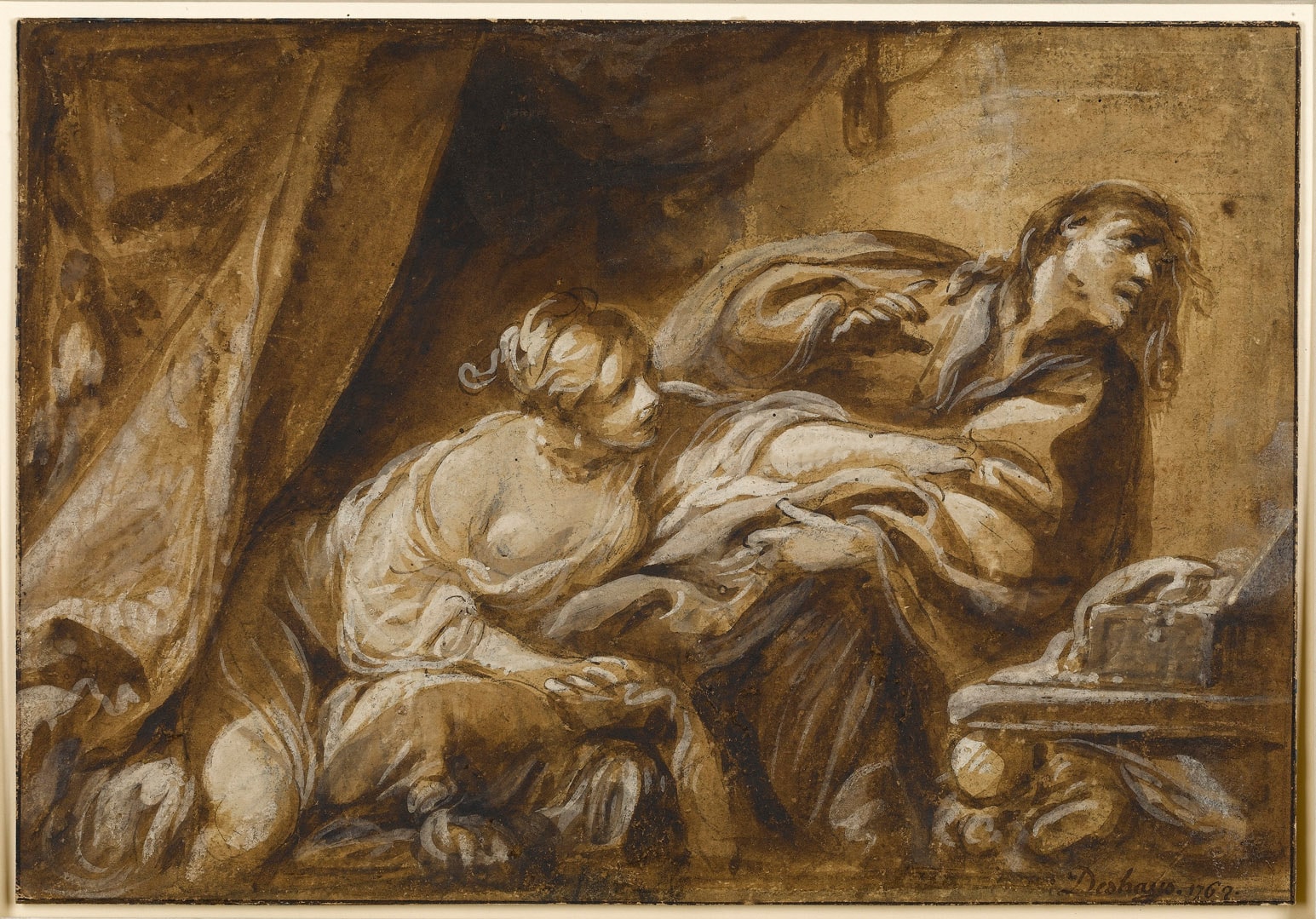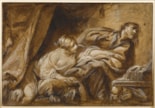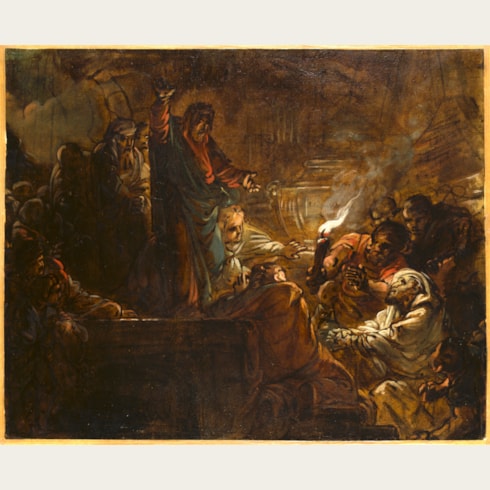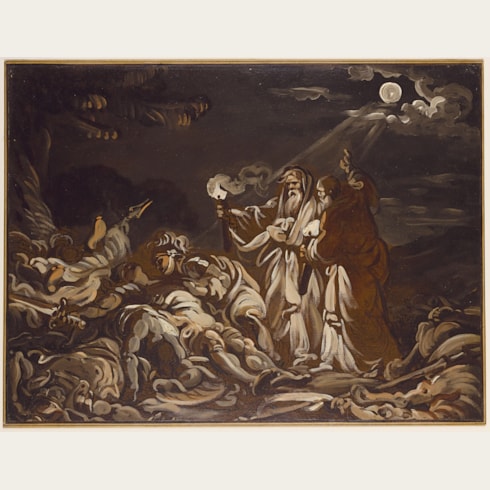Jean-Baptiste DESHAYS
(Colleville 1729 - Paris 1765)
Joseph and Potiphar’s Wife
Sold
Pen and brown ink and brown wash, extensively heightened with white, over an underdrawing in black chalk.
Signed and dated Deshays. 1762. at the lower right.
166 x 240 mm. (6 1/2 x 9 1/2 in.)
Signed and dated Deshays. 1762. at the lower right.
166 x 240 mm. (6 1/2 x 9 1/2 in.)
Around six hundred drawings were dispersed at the posthumous sale of the contents of Jean-Baptiste Deshays’ studio, probably including the present sheet which, with its vigorous handling of the pen and brush, is a fine example of the artist’s bold draughtsmanship. Deshays is known to have exhibited two paintings of the Old Testament subject of Joseph and Potiphar’s Wife, both of which are now lost. The first of these is a youthful work shown at the Ecole des Elèves Protégés in 1751; described as ‘la femme de Putiphar, accusant Joseph’, it may have depicted a different episode in the story from that shown in the present sheet. Dated 1762, this drawing is instead a preparatory study for a later painting of La Chasteté de Joseph, exhibited by Deshays at the Salon of 1763 and in the Seroux d’Agincourt collection by 1769. The painting was widely admired in reviews of the 1763 Salon, with Diderot lavishing particular praise: ‘Si l’on me donne un tableau à choisir au Salon, violà le mien; cherchez le vôtre. Vous en trouverez de plus savants, de plus parfaits peut-être; pour un plus séduisant, je vous en défie.’
The present sheet, aptly described as ‘fougueux et fort’ by André Bancel in his recent catalogue of the artist’s work, is the only surviving preparatory drawing by Deshays for the 1763 painting. Individual studies of each of the heads of the two protagonists were recorded in the 1765 Deshays studio sale, but these are now lost. These two drawings may have served as models for a pair of prints of the heads of Joseph and the wife of Potiphar by Louis-Marin Bonnet, one of which is dated 1769, although the prints show some differences in pose and expression with the figures in the present sheet.
It has recently been noted that ‘Deshays had a predilection for the sketch made with the brush as a preparation technique. The dynamic quality of the sketch accords well with his often dramatic subject matter, and he produced a great number relative to his overall output. They are...loose and energetic in their brushwork, yet with a fine sense of proportion and volume often absent in vigorous sketches.’ It is arguably in his oil sketches and in drawings such as the present sheet, rather in his relatively few surviving finished paintings, that Deshays’ abilities can best be seen to their best advantage.
The present sheet, aptly described as ‘fougueux et fort’ by André Bancel in his recent catalogue of the artist’s work, is the only surviving preparatory drawing by Deshays for the 1763 painting. Individual studies of each of the heads of the two protagonists were recorded in the 1765 Deshays studio sale, but these are now lost. These two drawings may have served as models for a pair of prints of the heads of Joseph and the wife of Potiphar by Louis-Marin Bonnet, one of which is dated 1769, although the prints show some differences in pose and expression with the figures in the present sheet.
It has recently been noted that ‘Deshays had a predilection for the sketch made with the brush as a preparation technique. The dynamic quality of the sketch accords well with his often dramatic subject matter, and he produced a great number relative to his overall output. They are...loose and energetic in their brushwork, yet with a fine sense of proportion and volume often absent in vigorous sketches.’ It is arguably in his oil sketches and in drawings such as the present sheet, rather in his relatively few surviving finished paintings, that Deshays’ abilities can best be seen to their best advantage.
Jean-Baptiste Deshays received his initial artistic training with Hyacinthe Collin de Vermont and Jean Restout. After winning the Prix de Rome in 1751, he studied for three years at the Ecole des Elèves Protégés and spent a further four years at the Académie de France in Rome. Agrée at the Académie Royale in 1758, Deshays was reçu the following year with a painting of Hector Laid on the Banks of the Scamander, which was exhibited at the Salon. (He exhibited a further two times at the Salon before his untimely death at the age of thirty-five, and again posthumously in 1765.) Deshays made a particular speciality of paintings of religious subjects, and received important commissions for such churches as Saint-Roch in Paris, Saint-Pierre in Douai and Saint-André in Rouen, for which he painted three major altarpieces between 1758 and 1761. He also designed two sets of tapestry cartoons for the manufactory at Beauvais.
As a painter, Deshays employed a loose and fluid manner that owed much to the example of the Baroque artists he had studied in Italy, as well as to François Boucher (whose daughter he married in 1758) and Jean-Honoré Fragonard. Writing of the Salon of 1761, Denis Diderot praised his work, noting that ‘This painter, in my opinion, is the nation’s foremost painter; he has more warmth and genius than Vien; he rivals Van Loo in drawing and color...There is strength and austerity in his palette; he conceives [the most] striking subjects.’1 Deshays achieved considerable success during his brief career, which lasted only about seven years before his early death. Some six hundred drawings were dispersed at the posthumous sale of Deshays’ studio.
Provenance
Possibly the posthumous vente Deshays, Paris, Pierre Remy, 26 March 1765 onwards, as part of lot 39 (Cinq autres idem, & la Chasteté de Joseph, faits à la plume, au bistre & rehausses de blanc, sur papier bleu, bt. Bourlamaque for 28 livres)
Possibly the posthumous Bourlamaque sale, 27 March 1770 onwards, lot 39 (Cinq dessins et la chasteté de Joseph)
Herman Shickman, New York, in 1966
Christian Humann, New York
His posthumous sale, New York, Sotheby Parke Bernet, 30 April 1982, lot 72
Jean Montague Massengale, Darien, CT and Santa Fe, NM
Her posthumous sale, London, Sotheby’s, 4 July 2007, lot 94.
Possibly the posthumous Bourlamaque sale, 27 March 1770 onwards, lot 39 (Cinq dessins et la chasteté de Joseph)
Herman Shickman, New York, in 1966
Christian Humann, New York
His posthumous sale, New York, Sotheby Parke Bernet, 30 April 1982, lot 72
Jean Montague Massengale, Darien, CT and Santa Fe, NM
Her posthumous sale, London, Sotheby’s, 4 July 2007, lot 94.
Literature
Marc Sandoz, Jean-Baptiste Deshays 1729-1765, Paris, 1977, p.63, no.5Bb, and p.155; André Bancel, Jean-Baptiste Deshays, Paris, 2008, p.64, p.160, under no.P.123, p.224, no.D90 (as location unknown); Rémi Freyermuth, Cahiers du dessin français, No.23: L’atelier de François Boucher, Paris, 2022, p.16, no.22, p.51, pl.22.






